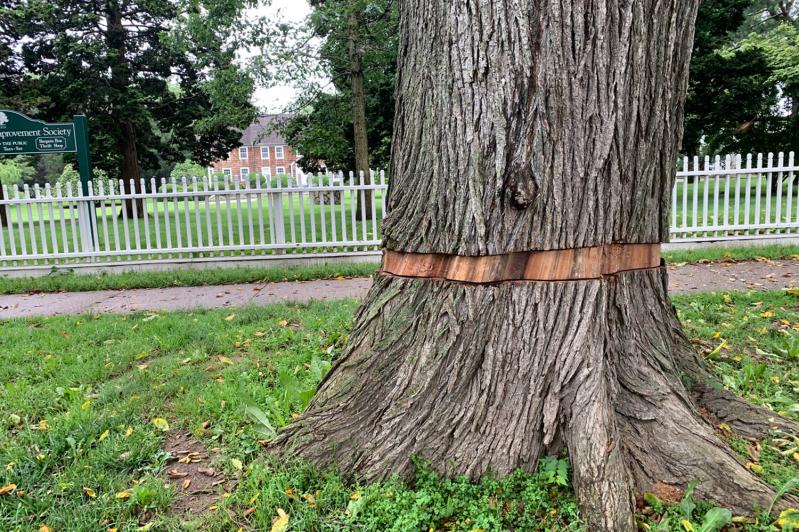If you’ve walked by the Ladies Village Improvement Society headquarters on East Hampton Main Street or waited at the Hampton Jitney stop in front of it, you may have noticed an elm with its bark cut away in a neat strip around the tree’s circumference.
“Won’t that kill the tree?” one curious walker asked The Star two weeks ago after spotting it. The answer is yes. So why intentionally kill one of the Amer- ican elm trees that make the entrance to the village so majestic?
The practice, called girdling, “is the traditional method of killing trees with- out felling them,” according to a United States Department of Agriculture Forest Service document. In this case, it’s being used to prevent the spread of Dutch elm disease, a fungal disease that has been attacking village trees since the 1950s, explained Olivia Brooks, the head of the L.V.I.S.’s tree committee.
“Girdling severs the bark, cambium, and sometimes the sapwood in a ring ex- tending entirely around the trunk of the tree,” the Forest Service says. The gap in the bark means the leaves cannot transfer energy back to the roots, and the roots eventually die.
The L.V.I.S. tree committee tends to the tree plaques at the base of many vil- lage trees but is also on the front lines watching for Dutch elm disease in 140 trees in consultation with Cornell Uni- versity. “All of our elms are treated or- ganically annually and chemically every other year,” Ms. Brooks said.
If the disease is detected early enough, “we can cut off the infected limb and treat the tree,” said Michael Bouker, the deputy superintendent of public works in the village. “We’ve tried that in the past, but it always seems the disease continues to spread.”
“The trees do a ‘handshake’ under- ground,” he said. “So, if a disease came down one tree it could go underground
and spread to the next.” Although Cor- nell recommended trenching to contain the spread, “we thought it best to girdle it — stop it from coming down past that point so there’s no way for it to spread underground.”
“In this instance the tree seemed to be failing very quickly,” he said.
After leafing out normally in May, it took a sudden turn for the worse, accord- ing to Ms. Brooks. “Because this tree sits in a busy site on Main Street with a num- ber of underground utility lines, this was the best solution to curtail the disease,” she wrote. “We are so sad to lose another ancient beauty. . . . We have an aggressive program but when the time is up, it’s up, unfortunately. Just like humans.”
“The tree is effectively dead,” said Mr. Bouker. He said it was well over 100 years old. To reduce impacts on traffic, the village will wait until at least the fall to remove it and two oth- er large trees near Newtown Lane and Main Street.
The L.V.I.S. will work with the village to plant new trees to replace those lost. “People have to realize that the trees we’re planting today aren’t for us, they’re for people who haven’t been born yet,” Mr. Bouker said. “One of the chances you take having these big, beautiful trees is that they’re susceptible to some nasty pathogens. . . . Even the best preventative maintenance does not guarantee that the tree will make it.”

